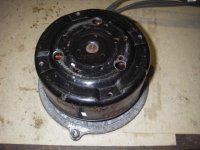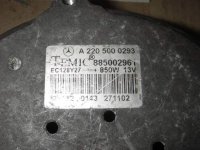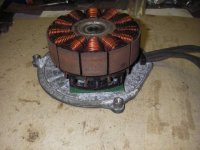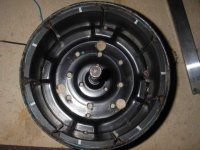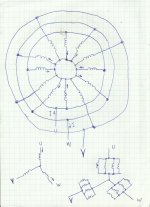Hello
I am Ruudi from Estonia and I am very interested in electric vehicles. This is the area where both of my main interests come together electricity and vehicles.
This is my first post in this forum. I have been reading a lot of your interesting topics here in this forum. But have not got answers for my questions yet.
I have Mercedes Benz engine cooling fan motor witch is BLDC outrunner with built in hall sensors. It is rated 850W and 13V. It has got 7 magnets on the rotor and 12 pole stator. It has usual ferrite magnets. Interesting is that this motor does not have any cogging at all if you rotate it by hand. What do you think is it electrically and magnetically a motor enough for big heavy 50cc scooter conversion?
On table with no load it was promising. I had kelly minicontroller connected to it and it worked fine at 48V 4,5A (from batteries) got 9200rpm even regen was working.
I have mounted it onto the scooter motor three different ways and it dissapointed me. Acceleration is wery poor top speed was 29 km/h. Tried everything: modified variator, locked it up, tried different belt drives. I think that this kelly mini controller is maybe too weak but it is rated 35A and my ammeter does not show over 20A I do not know why.
Anyway what do you think, what should I do to get more power out of this motor. Should I change the magnets to neodymium? Is it sensible to change the number of magnet poles to 8? More powerful controller from recommended e-crazyman is on its way
I am Ruudi from Estonia and I am very interested in electric vehicles. This is the area where both of my main interests come together electricity and vehicles.
This is my first post in this forum. I have been reading a lot of your interesting topics here in this forum. But have not got answers for my questions yet.
I have Mercedes Benz engine cooling fan motor witch is BLDC outrunner with built in hall sensors. It is rated 850W and 13V. It has got 7 magnets on the rotor and 12 pole stator. It has usual ferrite magnets. Interesting is that this motor does not have any cogging at all if you rotate it by hand. What do you think is it electrically and magnetically a motor enough for big heavy 50cc scooter conversion?
On table with no load it was promising. I had kelly minicontroller connected to it and it worked fine at 48V 4,5A (from batteries) got 9200rpm even regen was working.
I have mounted it onto the scooter motor three different ways and it dissapointed me. Acceleration is wery poor top speed was 29 km/h. Tried everything: modified variator, locked it up, tried different belt drives. I think that this kelly mini controller is maybe too weak but it is rated 35A and my ammeter does not show over 20A I do not know why.
Anyway what do you think, what should I do to get more power out of this motor. Should I change the magnets to neodymium? Is it sensible to change the number of magnet poles to 8? More powerful controller from recommended e-crazyman is on its way


